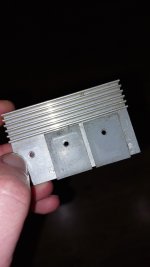Did you miss the word old?
Mica is the best, but it is fragile and difficult to handle, especially in automatic mode, which is why silicone insulators are preferred for industrial products.
It is preferable not to reuse silicone insulators for optimal results because the parameters degrade once it has already been used.
Mica is the best, but it is fragile and difficult to handle, especially in automatic mode, which is why silicone insulators are preferred for industrial products.
It is preferable not to reuse silicone insulators for optimal results because the parameters degrade once it has already been used.
Used silicone pads get crushed and conform to the old mounting, and won’t be as good thermally or electrically (insulation breakdown) a second time. Mica is brittle so it tears up easy.
If you can get old mica pads off without tearing up the corners or separating layers, AND get all the old grease off of them, they can be reused.
If you can get old mica pads off without tearing up the corners or separating layers, AND get all the old grease off of them, they can be reused.
The best thermal pads are expensive and ceramic, such as Al2O3 (alumina) or AlN (which have high thermal conductivity) - they also require very flat surfaces - easy to crack them. With less thermally conductive materials being thin is good (assuming the breakdown voltage is enough). It may pay to grind devices/heat-sinks flatter for better heat-transfer with thin or brittle pads.
There's another material sometimes used for pads but its very toxic and best avoided, BeO (beryllia).
Silicone pads are typically filled with a powder that increases the heat conductivity over pure silicone, so check the datasheets when comparing as specs's may vary.
For temporary/prototype use I've used a single layer of kapton tape as heatpad, not sure that's a good idea or not.
There's another material sometimes used for pads but its very toxic and best avoided, BeO (beryllia).
Silicone pads are typically filled with a powder that increases the heat conductivity over pure silicone, so check the datasheets when comparing as specs's may vary.
For temporary/prototype use I've used a single layer of kapton tape as heatpad, not sure that's a good idea or not.
Take care, any improvisation that works tends to become definitive.
I think that there is too much discussion about the 2-3 degree difference, generated by the insulators, at the temperature reached by the transistors. When a transistor dissipates 10-20W (continuously) the insulator is not really that critical. Otherwise, the problem arises if the dissipation approaches the maximum possible for the transistor.
I think that there is too much discussion about the 2-3 degree difference, generated by the insulators, at the temperature reached by the transistors. When a transistor dissipates 10-20W (continuously) the insulator is not really that critical. Otherwise, the problem arises if the dissipation approaches the maximum possible for the transistor.
arent this alumina? and painfully cheap..
https://www.lcsc.com/product-detail/Heat-sink-heatsink_Karefonte-yk22-30-0-635mm_C5439219.html
https://www.lcsc.com/product-detail/Heat-sink-heatsink_Karefonte-yk22-30-0-635mm_C5439219.html
The silicone pads I put in my amplifier in 1994 are apparently still working. At least the amplifier still works normally. It's a class-AB amplifier, so it doesn't get very hot. They were new in 1994.
If you need a really low thermal resistance: EUVL once compared various ways to insulate semiconductors from a heatsink and found that Keratherm Kerafol 86/82 works very well, see his article "Design considerations for a class-A amplifier enclosure" in Linear Audio volume 3.
See also https://www.diyaudio.com/community/threads/alternatives-to-mica-gold-tin-and-tantalum.386847/
If you need a really low thermal resistance: EUVL once compared various ways to insulate semiconductors from a heatsink and found that Keratherm Kerafol 86/82 works very well, see his article "Design considerations for a class-A amplifier enclosure" in Linear Audio volume 3.
See also https://www.diyaudio.com/community/threads/alternatives-to-mica-gold-tin-and-tantalum.386847/
- Home
- Design & Build
- Parts
- Thermal Pads

